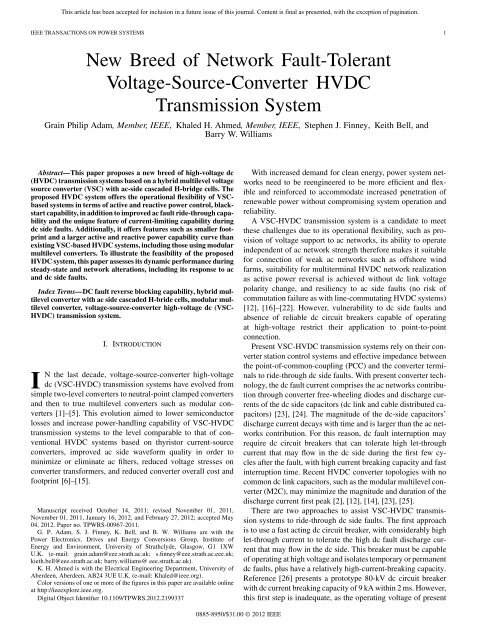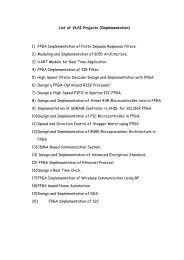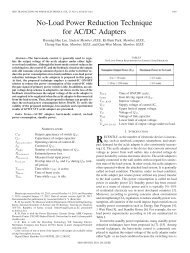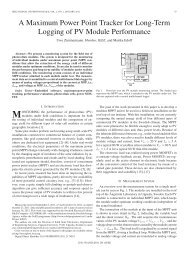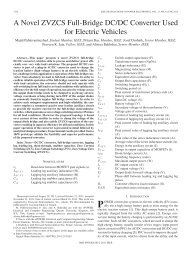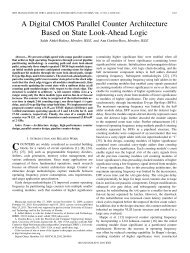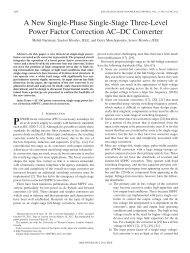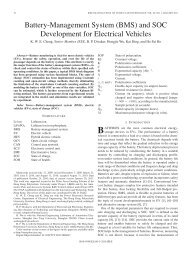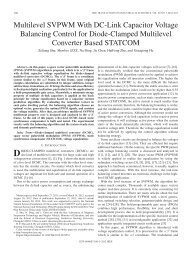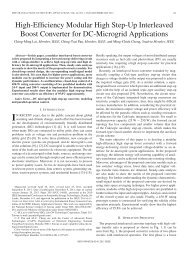New Breed of Network Fault-Tolerant Voltage-Source ... - IEEE Xplore
New Breed of Network Fault-Tolerant Voltage-Source ... - IEEE Xplore
New Breed of Network Fault-Tolerant Voltage-Source ... - IEEE Xplore
You also want an ePaper? Increase the reach of your titles
YUMPU automatically turns print PDFs into web optimized ePapers that Google loves.
This article has been accepted for inclusion in a future issue <strong>of</strong> this journal. Content is final as presented, with the exception <strong>of</strong> pagination.ADAM et al.: NEW BREED OF NETWORK FAULT-TOLERANT VOLTAGE-SOURCE-CONVERTER HVDC TRANSMISSION SYSTEM 7Fig. 3.Test network and waveforms demonstrating the steady-state operation <strong>of</strong> HVDC system based on hybrid voltage source multilevel converter with ac sidecascaded H-bridge cells. (a) Test network used to illustrate the viability <strong>of</strong> the hybrid multilevel voltage source converter HVDC systems; (b) active and reactivepower converter station 1 exchanges with PCC ; (c) active and reactive power converter station 2 exchanges with PCC ; (d) voltage magnitude at PCC ;(e) voltage waveforms at PCC ; (f) current waveforms converter station 1 exchanges with PCC ; (g) voltage across 21 cell capacitors <strong>of</strong> the three phases <strong>of</strong>converter 1; (h) voltage across the dc link <strong>of</strong> converter station 2.and converter 2 adjusts its reactive power exchange with gridin order support voltage at [see Fig. 4(d)]. The transientsshown <strong>of</strong> active and reactive powers at PCC2 are relatedto the reaction <strong>of</strong> the ac voltage controller that regulates the acvoltage at . Fig. 4(c) shows that the voltage magnitude atremains unaffected; confirming that the hybrid voltage
This article has been accepted for inclusion in a future issue <strong>of</strong> this journal. Content is final as presented, with the exception <strong>of</strong> pagination.ADAM et al.: NEW BREED OF NETWORK FAULT-TOLERANT VOLTAGE-SOURCE-CONVERTER HVDC TRANSMISSION SYSTEM 9Fig. 4. (Continued.) Waveforms demonstrating ac fault ride-through capability <strong>of</strong> HVDC transmission systems based on hybrid voltage multilevel converterwith ac side cascaded H-bridge cells. (k) <strong>Voltage</strong> magnitude at PCC1. (l) <strong>Voltage</strong> magnitude at PCC2. (m) Current waveforms converter 2 injects into PCC2.(n) Converter 2 dc link voltage. (o) <strong>Voltage</strong> across the 21 H-bridge cell capacitors <strong>of</strong> converter 2. Results in (i)–(o) demonstrate the case when the converterstations operate close to their maximum active power capabilities (power command at converter 1 is set to 0.75 pu, which is 515 MW) and system is subjected toa three-phase fault with a 300-ms duration.the transient power flow on the dc side, hence minimizing disturbanceon the dc link voltage. Fig. 4(g) shows that the H-bridgecell voltage stresses are controlled as the system rides throughthe ac-side fault. This confirms that the complexity <strong>of</strong> a HVDCsystem based on the hybrid multilevel VSC does not compromiseits ac fault ride-through capability. Fig. 4(h) shows the hybridmultilevel VSC presents high-quality voltage to the convertertransformer, with low harmonic content and . Thismay permit elimination <strong>of</strong> ac-side filters and the use <strong>of</strong> standardinsulation ac transmission transformers.The results in Fig. 4(i)–(o) are presented to demonstrate theability <strong>of</strong> the proposed HVDC system to operate in faulty networks,independent <strong>of</strong> its operating point and fault duration.This case demonstrates the superiority <strong>of</strong> current-limiting VSCsover a synchronous generator during ac network disturbances.(Converter 2 current injection into is always controlledand less than full load rated current despite the fault durationand the amount <strong>of</strong> power exchange between ac networksand .)C. DC <strong>Network</strong> <strong>Fault</strong>sThe inherent current-limiting capability <strong>of</strong> the hybrid multilevelVSC with ac-side cascaded H-bridge cells that permitsthe VSC-HVDC system to ride-through dc-side faults willbe demonstrated here. The test network is subjected to a 140ms solid pole-to-pole dc-side fault at the location indicatedin Fig. 3(a). During the dc-side fault period, active powerexchange between the two grids and is reduced tozero. This facilitates uninterruptable system recovery from thetemporary dc fault with minimal inrush current, since the powerpaths between the converter’s ac and dc sides are blocked(by inhibiting all converter gate signals) to eliminate a gridcontribution to the dc fault.Fig. 5 shows the results when the test network is subjected toa temporary solid pole-to-pole dc fault at the middle <strong>of</strong> the dclink. Fig. 5(a) and (b) shows the active and reactive powers thatconverter stations 1 and 2 exchange with and .Observe zero active and reactive power exchange between theconverter stations and ac grids and during the fault period,hence there is no current flow in the switches <strong>of</strong> converters1 and 2. However, a large surge in active and reactive poweris observed when the gating signals to converters 1 and 2 arerestored after the fault is cleared, in order to restart the system.Fig. 5(c) and (d) shows that the current surge experienced byboth converter stations causes noticeable voltage dipping atand due to increased consumption <strong>of</strong> reactivepower during system start-up and dc link voltage build-up followingfault clearance. The surge in active and reactive powersin both converter stations occurs as the dc side capacitors try to
This article has been accepted for inclusion in a future issue <strong>of</strong> this journal. Content is final as presented, with the exception <strong>of</strong> pagination.10 <strong>IEEE</strong> TRANSACTIONS ON POWER SYSTEMSFig. 5. Waveforms demonstrating dc fault ride-through capability <strong>of</strong> HVDC transmission systems based on hybrid voltage multilevel converter with ac side cascadedH-bridge cells. (a) Active and reactive power converter 1 exchanges with PCC . (b) Active and reactive power converter 2 exchanges with PCC . (c)<strong>Voltage</strong> magnitude at PCC . (d) <strong>Voltage</strong> magnitude at PCC . (e) Current waveforms converter 1 exchange with grid G at PCC . (f) Current waveforms converter2 exchange with grid G at PCC . (g) Converter 2 dc link voltage. (h) Zoomed version <strong>of</strong> dc link current demonstrating the benefits <strong>of</strong> dc fault reverseblocking capability.charge from both ac sides; this causes a large current flow fromboth ac sides to the dc side to charge the dc link capacitors andcable distributed capacitors as shown in Fig. 5(e) and 5(f). Theresults in Fig. 5(e) and 5(f) also demonstrate the benefits <strong>of</strong> dcfault reverse blocking capability inherent in this hybrid system,as the converter switches experience high current stresses onlyduring dc link voltage build-up. Fig. 5(g) shows that converter2 dc link voltage recovers to the pre-fault state after the fault
This article has been accepted for inclusion in a future issue <strong>of</strong> this journal. Content is final as presented, with the exception <strong>of</strong> pagination.ADAM et al.: NEW BREED OF NETWORK FAULT-TOLERANT VOLTAGE-SOURCE-CONVERTER HVDC TRANSMISSION SYSTEM 11Fig. 5. (Continued.) Waveforms demonstrating dc fault ride-through capability <strong>of</strong> HVDC transmission systems based on hybrid voltage multilevel converter withac side cascaded H-bridge cells. (i) <strong>Voltage</strong> across the H-bridge cell capacitors <strong>of</strong> converter 1. (j) <strong>Voltage</strong> across the H-bridge cell capacitors <strong>of</strong> converter 2.is cleared. Notice the recovery period for the dc link voltage isrelatively long; this is the major disadvantage <strong>of</strong> the proposedHVDC systems as it uses a common dc link capacitor. Fig. 5(h)expands the dc fault current and shows the 60-kA peak decaysto zero in less than four cycles (for 50 Hz) after discharge <strong>of</strong> dclink and cable distributed capacitors. This result confirms thepossibility <strong>of</strong> eliminating dc circuit breakers to isolate permanentdc side faults in dc networks that use HVDC converterswith current limiting capability. Fig. 5(h) also shows the acgrids start to contribute to the dc link current after the fault iscleared, to charge the dc side capacitors. Fig. 5(i) and (j) showsthe voltage across the 21 H-bridge cells <strong>of</strong> the converter stations1 and 2 (each group <strong>of</strong> traces represent voltages across 7H-bridge cell capacitors in each phase). The voltage across theH-bridge cell capacitors remains unaffected during the entirefault period as the converters are blocked. The cell capacitorsstart to contribute energy to the main dc link capacitors duringdc link voltage build-up after restoration <strong>of</strong> the converter gatingsignals. This contribution creates a noticeable reduction in thecell capacitor voltages during system restart. The cell capacitors<strong>of</strong> converter 2 that regulate dc link voltage, experience a largervoltage dip than converter 1, which regulates active power.However, the reduction in H-bridge cell capacitor voltages isminimized if large capacitance is used.V. CONCLUSIONThis paper presented a new generation VSC-HVDC transmissionsystem based on a hybrid multilevel converter with ac-sidecascaded H-bridge cells. The main advantages <strong>of</strong> the proposedHVDC system are:• potential small footprint and lower semiconductor lossescompared to present HVDC systems.• low filtering requirements on the ac sides and presentshigh-quality voltage to the converter transformer.• does not compromise the advantages <strong>of</strong> VSC-HVDC systemssuch as four-quadrant operation; voltage support capability;and black-start capability, which is vital for connection<strong>of</strong> weak ac networks with no generation and windfarms.• modular design and converter fault management (inclusion<strong>of</strong> redundant cells in each phase may allow the system tooperate normally during failure <strong>of</strong> a few H-bridge cells;whence a cell bypass mechanism is required).• resilient to ac side faults (symmetrical and asymmetrical).• inherent dc fault reverse blocking capability that allowsconverter stations to block the power paths between the acand dc sides during dc side faults (active power betweenac and dc sides, and reactive power exchange between aconverter station and ac networks), hence eliminating anygrid contribution to the dc fault current.REFERENCES[1] G. P. Adam et al., “<strong>Network</strong> fault tolerant voltage-source-convertersfor high-voltage applications,” in Proc. 9th IET Int. Conf. AC and DCPower Transmission, London, U.K., 2010, pp. 1–5.[2] Y. Zhang et al., “<strong>Voltage</strong> source converter in high voltage applications:Multilevel versus two-level converters,” in Proc. 9th IET Int. Conf. ACand DC Power Transmission, London, U.K., 2010, pp. 1–5.[3] G. P. Adam et al., “Modular multilevel inverter: Pulse width modulationand capacitor balancing technique,” IET Power Electron., vol. 3,pp. 702–715, 2010.[4] M. M. C. Merlin et al., “A new hybrid multi-level voltage-source converterwith DC fault blocking capability,” in Proc. 9th IET Int. Conf.AC and DC Power Transmission, London, U.K., 2010, pp. 1–5.[5] V. Naumanen et al., “Mitigation <strong>of</strong> high du=dt-originated motor overvoltagesin multilevel inverter drives,” IET Power Electron., vol. 3, pp.681–689, 2010.[6] H. Abu-Rub et al., “Medium-voltage multilevel converters: State <strong>of</strong>the art, challenges, and requirements in industrial applications,” <strong>IEEE</strong>Trans. Ind. Electron., vol. 57, no. 8, pp. 2581–2596, Aug. 2010.[7] G. P. Adam et al., “Modular multilevel converter for medium-voltageapplications,” in Proc. <strong>IEEE</strong> Int. Conf. Electr. Mach. Drives Conf.,2011, pp. 1013–1018.[8] G. P. Adam, S. J. Finney, A. M. Massoud, and B. W. Williams, “Capacitorbalance issues <strong>of</strong> the diode-clamped multilevel inverter operated ina quasi-two-state mode,” <strong>IEEE</strong> Trans. Ind. Electron., vol. 55, no. 8, pp.3088–3099, Aug. 2008.[9] M. Chaves et al., “<strong>New</strong> approach in back-to-back m-leveldiodeclamped multilevel converter modelling and direct currentbus voltages balancing,” IET Power Electron., vol. 3, pp. 578–589,2010.[10] N. Flourentzou et al., “VSC-based HVDC power transmission systems:An overview,” <strong>IEEE</strong> Trans. Power Electron., vol. 24, no. 3, pp.592–602, Mar. 2009.[11] L. G. Franquelo et al., “The age <strong>of</strong> multilevel converters arrives,” <strong>IEEE</strong>Ind. Electron. Mag., vol. 2, no. 1, pp. 28–39, 2008.[12] U. N. Gnanarathna et al., “Efficient modeling <strong>of</strong> modular multilevelHVDC converters (MMC) on electromagnetic transient simulation programs,”<strong>IEEE</strong> Trans. Power Del., vol. 26, no. 1, pp. 316–324, Jan. 2011.[13] S. Kouro et al., “Recent advances and industrial applications <strong>of</strong>multilevel converters,” <strong>IEEE</strong> Trans. Ind. Electron., vol. 57, no. 8, pp.2553–2580, Aug. 2010.[14] G. P. Adam et al., “Steady-state and transient performance <strong>of</strong> DC transmissionsystems based on HVDC technology,” in Proc. 9th IET Int.Conf. ACDC Power Transmission, 2010, pp. 1–5.
This article has been accepted for inclusion in a future issue <strong>of</strong> this journal. Content is final as presented, with the exception <strong>of</strong> pagination.12 <strong>IEEE</strong> TRANSACTIONS ON POWER SYSTEMS[15] C. Du et al., “VSC-HVDC system for industrial plants with onsite generators,”<strong>IEEE</strong> Trans. Power Del., vol. 24, no. 3, pp. 1359–1366, Jul.2009.[16] D. Guanjun et al., “<strong>New</strong> technologies <strong>of</strong> voltage source converter(VSC) for HVDC transmission system based on VSC,” in Proc.<strong>IEEE</strong> Power Energy Soc. Gen. Meeting—Conversion and Delivery <strong>of</strong>Electrical Energy in the 21st Century, 2008, pp. 1–8.[17] N. Flourentzou and V. G. Agelidis, “Optimized modulation for AC-DCharmonic immunity in VSC HVDC transmission,” <strong>IEEE</strong> Trans. PowerDel., vol. 25, no. 3, pp. 1713–1720, Jul. 2010.[18] D. Cuiqing et al., “Use <strong>of</strong> VSC-HVDC for industrial systems havingonsite generation with frequency control,” <strong>IEEE</strong> Trans. Power Del., vol.23, no. 4, pp. 2233–2240, Oct. 2008.[19] Z. Huang et al., “Exploiting voltage support <strong>of</strong> voltage-source HVDC,”Proc. Inst. Electr. Eng.—Gen., Transm. Distrib., vol. 150, pp. 252–256,2003.[20] G. Kalcon et al., “HVDC network: Wind power integration and creation<strong>of</strong> super grid,” in Proc. 10th Int. Conf. Environ. Electr. Eng., 2011, pp.1–4.[21] D. Hui et al., “Analysis <strong>of</strong> coupling effects on overhead VSC-HVDCtransmission lines from AC lines with shared right <strong>of</strong> way,” <strong>IEEE</strong> Trans.Power Del., vol. 25, pp. 2976–2986, 2010.[22] B. T. Ooi and X. Wang, “Boost-type PWM HVDC transmissionsystem,” <strong>IEEE</strong> Trans. Power Del., vol. 6, no. 4, pp. 1557–1563, Oct.1991.[23] G. P. Adam et al., “HVDC <strong>Network</strong>: DC fault ride-through improvement,”in Proc. Cigre Canada Conf. Power Syst., Halifax, NS, Canada,Sep. 6–8, 2011, pp. 1–8.[24] G. P. Adam et al., “Dynamic behaviour <strong>of</strong> five-level grid connectedmodular inverters,” in Proc. 9th Int. Conf. Environ. Electr. Eng., 2010,pp. 461–464.[25] M. Perez et al., “Predictive control <strong>of</strong> AC-AC modular multilevel converters,”<strong>IEEE</strong> Trans. Ind. Electron., vol. 59, no. 7, pp. 2832–2839, Jul.2012.[26] J. Háfner and B. Jacobson, “Proactive hybrid HVDC breakers—A keyinnovation for reliable HVDC grids,” in Proc. Cigre Conf., Bologna,Italy, Sep. 13-15, 2011, pp. 1–8.Khaled H. Ahmed (M’10) received the B.Sc. (firstclass honours) and M.Sc. degrees from the Faculty<strong>of</strong> Engineering, Alexandria University, Alexandria,Egypt, in 2002 and 2004, respectively, and the Ph.D.degree in electrical engineering from the University<strong>of</strong> Strathclyde, Glasgow, U.K., in 2008.Since 2009, he has been a Lecturer with AlexandriaUniversity, Alexandria, Egypt. He has authoredor coauthored more than 39 technical papers in refereedjournals and conferences. He is a reviewer forthe <strong>IEEE</strong> transactions and several conferences. Hisresearch interests are digital control <strong>of</strong> power electronic systems, power quality,micro-grids, distributed generation, dc–dc converters, and HVDC.Stephen J. Finney received the M.Eng. degree fromLoughborough University <strong>of</strong> Technology, Loughborough,U.K., in 1988, and the Ph.D. degree fromHeriot-Watt University, Edinburgh, U.K., in 1995.For two years, he was with the Electricity CouncilResearch Centre Laboratories, Chester, U.K. He iscurrently a Pr<strong>of</strong>essor with the University <strong>of</strong> Strathclyde,Glasgow, U.K. His areas <strong>of</strong> research interestare s<strong>of</strong>t-switching techniques, power semiconductorprotection, energy recovery snubber circuits, andlow-distortion rectifier topologies.Keith Bell received the B.Eng. (Hons) and Ph.D. inelectrical engineering from the University <strong>of</strong> Bath,Bath, U.K., in 1990 and 1995, respectively.He is a Reader with the Department <strong>of</strong> Electronicand Electrical Engineering, University <strong>of</strong> Strathclyde,Glasgow, U.K. Between 1998 and 2005,he was with National Grid, Warwick, U.K. Hisresearch interests include power system planningand operation, electricity markets, regulation, andgrid integration <strong>of</strong> renewables.Dr. Bell received the CIGRE Technical CommitteeAward in 2010 and is a Member <strong>of</strong> the IET and is a Chartered Engineer in theU.K. He is a member <strong>of</strong> CIGRE Study Committee C1 on System Developmentand Economics, the IET Power Academy Council and the <strong>IEEE</strong> CAMS TaskForce on Understanding, Mitigation and Prevention <strong>of</strong> Cascading Outages.Grain Philip Adam (M’12) received the Ph.D.degree in power electronics from the University <strong>of</strong>Strathclyde, Glasgow, U.K., in 2007He is a Research Fellow with the Institute <strong>of</strong>Energy and Environment, University <strong>of</strong> Strathclyde,Glasgow, U.K. His research interests are fault-tolerantvoltage-source multilevel converters for HVDCsystems, control <strong>of</strong> HVDC transmission systems andmultiterminal HVDC networks, voltage-source-converter-basedFACTS devices, and grid integrationissues <strong>of</strong> renewable energies. He has authored andcoauthored several technical reports and journal and conference papers inthe area <strong>of</strong> multilevel converters and HVDC systems, and grid integration <strong>of</strong>renewable power. Also, he has contributed in reviewing process for several<strong>IEEE</strong> and IET transactions, journals, and conferences.Barry W. Williams received the M.Eng.Sc. degreefrom the University <strong>of</strong> Adelaide, Adelaide, Australia,in 1978, and the Ph.D. degree from Cambridge University,Cambridge, U.K., in 1980.After seven years as a Lecturer with Imperial College,University <strong>of</strong> London, London, U.K., he was appointedto a Chair <strong>of</strong> Electrical Engineering at Heriot-Watt University, Edinburgh, U.K., in 1986. He is currentlya Pr<strong>of</strong>essor with the University <strong>of</strong> Strathclyde,Glasgow, U.K. His teaching covers power electronics(in which he has a free internet text) and drive systems.His research activities include power semiconductor modeling and protection,converter topologies, s<strong>of</strong>t switching techniques, and application <strong>of</strong> ASICsand microprocessors to industrial electronics.


